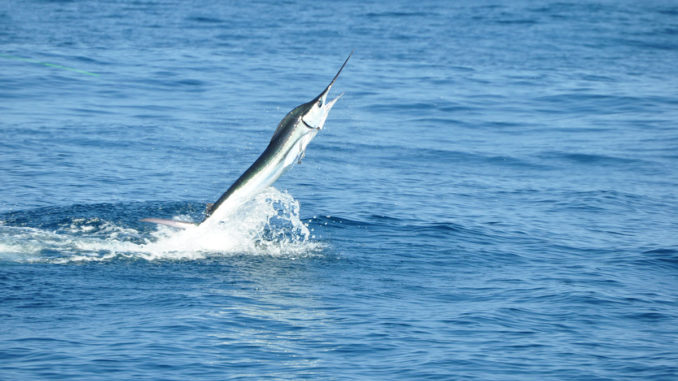
Oregon Inlet anglers welcome billfish
Although blue marlin may be the most-romanticized member of the marlin family due to their size, it’s their smaller cousin, the white marlin, that will be causing all the fuss around North Carolina’s Oregon Inlet this month, when fish congregate around massive bait schools found in Gulf Stream eddies, fattening up before cooler weather pushes them south.
“Usually around the second week of August, we start to see white marlin northeast of Oregon Inlet, from the 800 line to well north of the 000s,” said Karl Helmkamp of Fistful Sportfishing in Kill Devil Hills, N.C. “We look for pockets of warm, clear water in 35 to 100 fathoms with bait. Seventy-eight degrees seems to be a preferred temperature.”
Since white marlin aren’t likely to be controlled by bottom contour — unless it’s a high-profile structure that produces a current break — satellite imaging will help finding the correct conditions and a place to get started. Viewing a reliable sea-surface temperature chart will show the temperature breaks that signal where a desirable eddy has split off, harboring baitfish and the slower-moving water preferred by white marlin. From there, the exact location of baitfish is often nailed down by looking for birds.
Anglers targeting white marlin can enjoy luxuries seldom seen in blue marlin fishing: double-digit catches and stand-up tackle. Rarely reaching 100 pounds and averaging between 40 and 60, white marlin can be targeted with relatively light gear. Reels in the 20 to 25 class spooled with a 50- to 65-pound braid attached to a top shot of 30- to 50-pound monofilament will do the trick. A 6-foot, 80-pound fluorocarbon leader connected by a swivel is recommended. Baits can be bridled with floss or wire to a 7/0 circle hook.
“We typically fish with a 5-pole spread of naked ballyhoo and a sixth pole with pitch bait on an 80-wide ready for a blue marlin,” said Helmkamp (252-395- 1907). “I prefer fishing two longriggers, two flatlines and a shotgun rig in the middle of my spread. We pull two teasers and two dredges most days. Dredges are rigged with ballyhoo or mullet, depending on the day. Our mate likes to put a bigger bait behind each teaser with an Islander-style rig in front, typically in a darker color. Pink and green teasers are always a go-to, but colors vary wildly. There’s really no wrong way to do it as long as you’re seeing fish. You just have to get a hook in one, and everybody’s happy.”



Be the first to comment